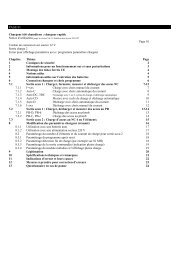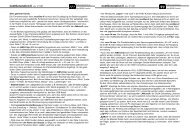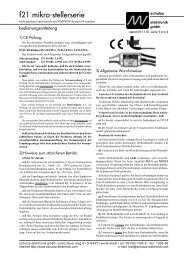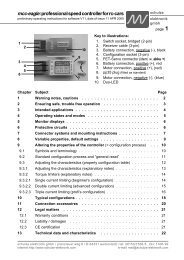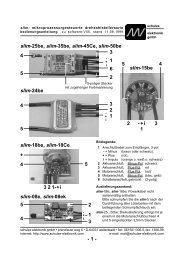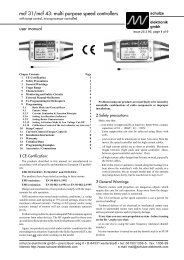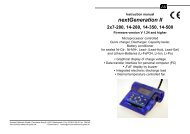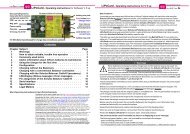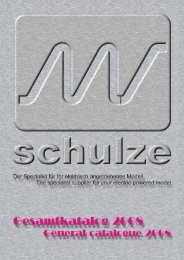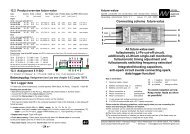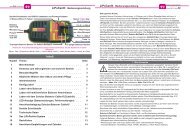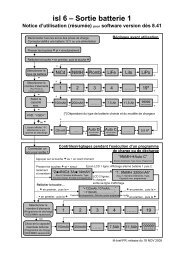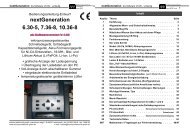ecolader: rapid discharger/charger series - Schulze Elektronik GmbH
ecolader: rapid discharger/charger series - Schulze Elektronik GmbH
ecolader: rapid discharger/charger series - Schulze Elektronik GmbH
You also want an ePaper? Increase the reach of your titles
YUMPU automatically turns print PDFs into web optimized ePapers that Google loves.
<strong>ecolader</strong>: <strong>rapid</strong> <strong>dis<strong>charger</strong></strong>/<strong>charger</strong> <strong>series</strong><br />
Operating instructions for software V1.04, date of issue 05 MAY 1998<br />
16 Fault-finding, fault correction<br />
schulze<br />
elektronik<br />
gmbh<br />
Page 35<br />
Dear customer,<br />
If your battery <strong>charger</strong> does not appear to work as you expect it to, please run through the<br />
meas-ures described below one by one.<br />
If - and only if - you observe all these points, and the problem still persists, telephone us on<br />
Tuesday or Thursday for technical assistance. Even better, fill in the service questionnaire (on the<br />
next page) and send or fax it to us. We will then ring you back with our advice.<br />
From our many years' experience with battery <strong>charger</strong>s we know that most errors and<br />
faults can be avoided from the outset if you observe the measures outlined below.<br />
If you send your <strong>charger</strong> to us and we find no defect - a situation which in most cases involves<br />
one or other of the causes described below - we are obliged to point out to you that<br />
we charge for our time in checking equipment that is found to be in perfect working order,<br />
even if the unit is still under warranty.<br />
1. Connect the <strong>charger</strong> to a fully charged car battery of at least 36 Ah capacity. Don't use a<br />
mains-powered PSU!<br />
2. Be sure to use the original power cable to the power supply (with the original 4mm gold plated<br />
plugs), and at the car battery soldered 4mm sockets. Other types of connector, such as cheap banana<br />
plugs, car cigar lighter plugs etc. ... are not suitable! If you have made changes, kindly restore the original<br />
equipment. Soldered joints must be really sound - don't be satisfied with a bodged job.<br />
3. The charge cables for all batteries should consist of 2.5 sq mm cross-section conductors. The<br />
<strong>charger</strong>'s automatic current setting circuit is only able to set the ideal (high) charge current for your<br />
battery if it is using this heavy cable. You will be doing the charge termination circuit a real favour!<br />
4. Just as important as the charge cables are the connectors attached to them. At the <strong>charger</strong><br />
end please use 4 mm gold-contact connectors which have proved excellent in practice. Don't use<br />
expen-sive multi-contact plugs; in any case matching gold-contact connectors should also be fitted<br />
to your drive batteries and flight packs. Tin-plated connectors are simply not suitable as their contact<br />
resis-tance is high and they tend to produce intermittent contact in the long-term.<br />
5. Provided that you adhere to the measures outlined under points 3) and 4) above, the fully automatic<br />
charge setting circuit should produce a charge current of at least 1 C and usually more than<br />
2 C after about 5-10 minutes of charging a discharged pack. If this is not the case, then most likely<br />
the internal resistance of your battery is too high. Your battery has "had it", or is not suitable for <strong>rapid</strong>-charg-ing.<br />
6. Ensure that your battery pack contains no "dud" cells. When on charge any faulty cells usually<br />
heat up early, and then cause the automatic charge termination circuit to trip prematurely, and/or<br />
produce an excessively low charge current in automatic mode.<br />
7. If you charge a pack at the Akku 1 or Akku 2 output using an automatic program, and the<br />
charge time is longer than three hours, then something is wrong with your charge cable, your connectors<br />
or your battery - perhaps too small a charge lead conductor cross-section? Or no high-quality<br />
gold-contact connectors? Maybe your battery is ripe for retirement, or is not suitable for <strong>rapid</strong>charg-ing<br />
at all.<br />
Establish the cause! Raising the maximum charge time limit is not the right route to take; in fact, if<br />
your charge times are close to one hour this usually indicates that something is less than ideal. The<br />
automatic current calculation circuit should set a charge current of 1 C after just 5-10 minutes!<br />
8. Have you also read and observed the information in Section 1 (Warnings) and 2 (How to obtain<br />
reliable, trouble-free operation)?<br />
schulze elektronik gmbh • prenzlauer weg 6 • D-64331 weiterstadt • tel: 06150/1306-5, fax: 1306-99<br />
internet: http://www.schulze-elektronik.com e-mail: mail@schulze-elektronik.com



